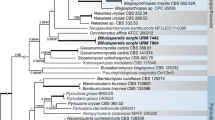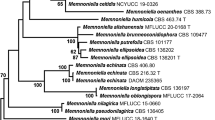Abstract
Gibellulopsis chrysanthemi sp. nov. is described and illustrated from specimens on rotten leaves of garland chrysanthemum (Chrysanthemum coronarium L. var. spatiosum L.H. Bailey), collected in three different sites of Osaka Prefecture, Japan. This species is characterized by having short and long verticillium-like conidiophores, 1-septate, long-cylindrical conidia with tapering ends and slightly brownish chlamydospores. Compared morphologically with other species in the Plectosphaerellaceae (sister to the Glomerellales), G. chrysanthemi is similar to Gibellulopsis nigrescens, from which it differs in the formation of long conidiophores and 1-septate, long-cylindrical conidia with tapering ends. In addition, the molecular analyses of G. chrysanthemi and other members of the Plectosphaerellaceae based on a phylogenetic tree with three-loci (ITS, D1/D2, tef1-α) sequences reveal that G. chrysanthemi is located as a sister group of G. nigrescens.


Similar content being viewed by others
References
Batista AC, da Silva Maia H (1959) Uma nova doença fúngica de peixe ornamental. An Soc Biol Pernambuco 16:153–159
Cannon PF, Buddie AG, Bridge PD, de Neergaard E, Lübeck M, Askar MM (2012) Lectera, a new genus of the Plectosphaerellaceae for the legume pathogen Volutella colletotrichoides. MycoKeys 3:23–36
Carbone I, Kohn LM (1999) A method for designing primer sets for speciation studies in filamentous ascomycetes. Mycologia 91:553–556
Carlucci A, Raimondo ML, Santos J, Phillips AJL (2012) Plectosphaerella species associated with root and collar rots of horticultural crops in southern Italy. Persoonia 28:34–48
Crane JL, Schoknecht JD (1973) Conidiogenesis in Ceratocystis ulmi, Ceratocystis piceae and Graphium penicillioides. Am J Bot 60:346–354. doi:10.2307/2441201
De Gruyter J, Woudenberg JHC, Aveskamp MM, Verkley GJM, Groenewald JZ, Crous PW (2012) Rediposition of Phoma-like anamorphs in Pleosporales. Stud Mycol 75:1–36
Farr DF, Rossman AY (2012) Fungal Databases, Systematic Mycology and Microbiology Laboratory, ARS, USDA. Retrieved 2 October 2012. (http://nt.ars-grin.gov/fungaldatabases/)
Gams W (1971) Cephalosporium-artige Schimmelpilze (Hyphomycetes). Gustav Fischer, Stuttgart
Gams W, Zare R, Summerbell RC (2005) Proposal to conserve the generic name Verticillium (anamorphic Ascomycetes) with a conserved type. Taxon 54:179
Glenn A, Bacon CW, Price R, Hanlin RT (1996) Molecular phylogeny of Acremonium and its taxonomic implications. Mycologia 88:369–383
Hirooka Y, Kobayashi T, Ono T, Rossman AY, Chaverri P (2010) Verrucostoma, a new genus in the Bionectriaceae from the Bonin Islands, Japan. Mycologia 102:418–429
Hirooka Y, Masuya H, Akiba M, Kubono T (2012) Sydowia japonica, a new name for Leptosphaerulina japonica based on morphological and molecular data. Mycol Prog, in press
Huelsenbeck JP, Ronquist F, Nielsen ES, Bollback JP (2001) Bayesian inference of phylogeny and its impact on evolutionary biology. Science 294:2310–2314
Huelsenbeck JP, Larget B, Miller RE, Ronquist F (2002) Potential applications and pitfalls of Bayesian inference of phylogeny. Syst Biol 51:673–688
Huxley AJ, Griffiths M, Levy M (1992) Dendranthema. In: Huxley AJ, Griffiths M, Levy M (eds) The new royal horticultural society dictionary of gardening. Macmillan Reference Limited, London, pp 33–34, vol 2
Ingold CT (1971) Fungal spores, their liberation and dispersal. Clarendon, Oxford
Inderbitzin P, Bostock RM, Davis RM, Usami T, Platt HW, Subbarao KV (2011) Phylogenetics and taxonomy of the fungal vascular wilt pathogen Verticillium, with the descriptions of five new species. PLoS One 6(12):e28341. doi:10.1371/journal.pone.0028341
Katoh T (2008) Recent developments in the MAFFT multiple sequence alignment program. Brief Bioinforma 9:286–298
Kirk PM, Cannon PF, David JC, Stalpers JA (eds) (2008) Ainsworth & Bisby’s dictionary of the fungi, 10th edn. CAB International, Wallingford
Kornerup A, Wanscher JH (1978) Methuen handbook of colour, 3rd edn. Methuen, London
Maddison WP, Maddison DR (2010) Mesquite: a modular system for evolutionary analysis. Version 2.73 http://mesquiteproject.org. Accessed February 2012
Malloch D, Blackwell M (1993) Dispersal biology of the ophiostomatoid fungi. In: Wingfield MJ, Seifert KA, Webber JF (eds) Ceratocystis and Ophiostoma: taxonomy, ecology, and pathogenicity. American Phytopathological Society Press, St Paul, pp 195–206
O’Donnell K (1993)Fusarium and its near relatives. In: Reynolds DR, Taylor JW (eds) The fungal holomorph: mitotic, meiotic and pleomorphic speciation in fungal systematics. CAB International, Wallingford, pp 225–233
Posada D (2008) jModelTest:Phylogenetic Model Averaging. http://darwin.uvigo.es/
Posada D, Buckley TR (2004) Model selection and model averaging in phylogenetics: advantages of the AIC and Bayesian approaches over likelihood ratio tests. Syst Biol 53:793–808
Rehner SA (2001) Primers for elongation factor 1-α (EF1-α). http://www.nacse.org/yfaaberg/aftol/EF1primer.pdf
Satou M, Chikuo Y, Matsushita Y, Sumitomo K (2010) Cutting rot of chrysanthemum (Chrysanthemum morifolium) caused by Plectosporium tabacinum. J Gen Plant Pathol 76:225–228
Schoch CL, Sung GH, Lopez-Giraldez F, Townsend JP, Miadlikowska J, Hofstetter V, Robbertse B, Matheny PB, Kauff F, Wang Z, Guiedan C, Andrie RM, Trippe K, Ciufetti LM, Wynns A, Fraker E, Hodkinson BP, Bonito G, Yahr R, Groenewald JZ, Arzanlou M, de Hoog GS, Crous PW, Hewitt D, Pfister DH, Peterson K, Gryzenhout M, Wingfield MJ, Aptroot A, Suh SO, Blackwell M, Hillis DM, Griffith GW, Castlebury LA, Rossman AY, Lumbsch HT, Lucking R, Budel B, Rauhut A, Diederich P, Ertz D, Geiser DM, Hosaka K, Inderbitzin P, Kohlmeyer J, Volkmann-Kohlmeyer B, Mostert L, O’Donnell K, Sipman H, Rogers JD, Shoemaker RA, Sugiyama J, Summerbell RC, Untereiner W, Johnston P, Stenroos S, Zuccaro A, Dyer PS, Crittenden PD, Cole MS, Hansen K, Trappe JM, Lutzoni F, Spatafora JW (2009) The Ascomycota tree of life: a phylum wide phylogeny clarifies the origin and evolution of fundamental reproductive and ecological traits. Syst Biol 58:224–239
Summerbell RC, Gueidan C, Schroers H-J, de Hoog GS, Starink M, Arocha Rosete Y, Guarro J, Scott JA (2011) Acremonium phylogenetic overview and revision of Gliomastix, Sarocladium, and Trichothecium. Stud Mycol 68:139–162. doi:10.3114/sim.2011.68.06
Swofford DL (2002) PAUP*. Phylogenetic analysis using parsimony (*and other methods), ver 4.10. Sinauer Associates, Sunderland
Trehane P (1995) Proposal to conserve Chrysanthemum L. with a conserved type (Compositae). Taxon 44:439–441
White T, Bruns JTD, Lee S, Taylor J (1990) Amplification and direct sequencing of fungal ribosomal RNA sequences for phylogenetics. In: Innis MA, Gelfand DH, Sninsky JJ, White TJ (eds) PCR Protocols: a guide to methods and applications. Academic, San Diego, pp 315–322
Wingfield MJ, Seifert KA, Webber JF (1993) Ceratocystis and ophiostoma: taxonomy, ecology and pathogenicity. APS Press, St. Paul, pp 1–304
Zachos DG, Constanttinou PT, Panagopoulos CG (1960) Une trachéomycose du Chrysanthème causée par une nouvelle espèce de Cephalosporium. Annls Inst Phytopath Benaki N S 3:50–59
Zare R, Gams W, Starink-Willemse M, Summerbell RC (2007) Gibellulopsis, a suitable genus for Verticillium nigrescens, and Musicillium, a new genus for V. theobromae. Nova Hedwigia 85:463–489
Zwickl DJ (2006) GARLI, Genetic Algorithm for Rapid Likelihood Inference, Version 0.951. Available from: http://www.zo.utexas.edu/faculty/antisense/garli/Garli.html
Acknowledgments
We sincerely thank Drs Rasoul Zare and Walter Gams for providing informative comments to determine the species delimitation of G. chrysanthemi. We also acknowledge a second, anonymous reviewer for constructive comments on the manuscript.
Author information
Authors and Affiliations
Corresponding author
Rights and permissions
About this article
Cite this article
Hirooka, Y., Kawaradani, M. & Sato, T. Description of Gibellulopsis chrysanthemi sp. nov. from leaves of garland chrysanthemum. Mycol Progress 13, 13–19 (2014). https://doi.org/10.1007/s11557-012-0887-x
Received:
Revised:
Accepted:
Published:
Issue Date:
DOI: https://doi.org/10.1007/s11557-012-0887-x




